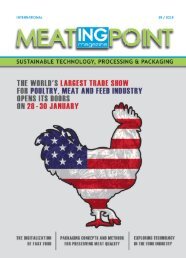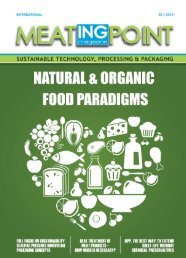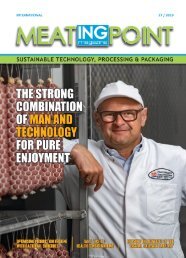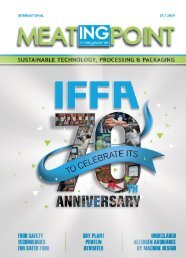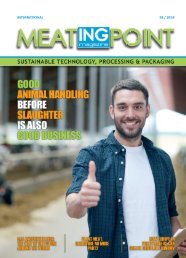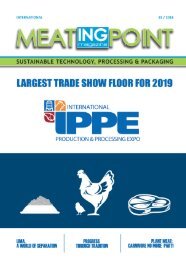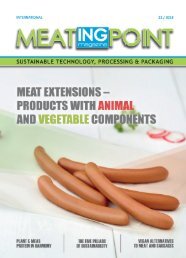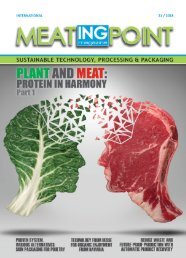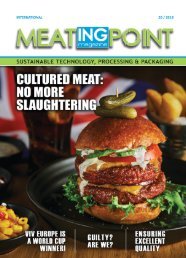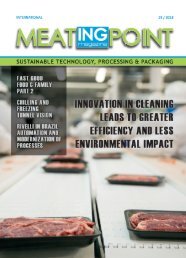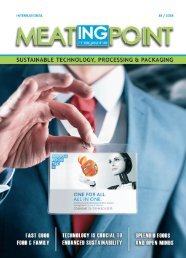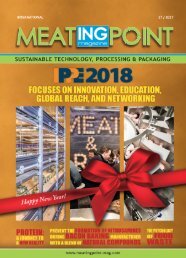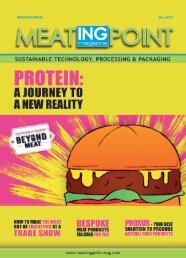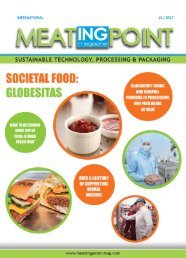MEATing POINT Magazine: #08/ 2016
Create successful ePaper yourself
Turn your PDF publications into a flip-book with our unique Google optimized e-Paper software.
PACKAGING<br />
THE FUTURE IS BRIGHT FOR<br />
POULTRY PACKAGING<br />
Innovation in poultry packaging is driving<br />
change in the sector as European packers<br />
and retailers look for more sustainable and<br />
novel solutions to maximise sales, according<br />
to Alan Davey, Innovation Director, at fresh<br />
food packaging manufacturer, LINPAC.<br />
Traditionally, polypropylene (PP) has been<br />
the material of choice for poultry packaging<br />
in several parts of Europe, but limitations<br />
in terms of its environmental credentials,<br />
barrier performance and shelf appeal have<br />
resulted in increased demand for Rfresh<br />
PET packaging.<br />
Mr Davey at LINPAC said: “Changing<br />
consumer lifestyles and heightened awareness<br />
of environmental issues, such as food and<br />
packaging waste, are behind this shift from<br />
PP to Rfresh PET packaging.<br />
“PET has been a popular choice for poultry<br />
packaging for some time but the full range<br />
of benefits that the material has over PP<br />
are only just beginning to be recognised by<br />
packers and retailers. Beyond the aesthetic<br />
benefits given by PET’s clarity and sparkle,<br />
lie environmental credentials and much<br />
better gas barrier performance. But PET also<br />
introduces greater production efficiencies<br />
to packing lines.”<br />
Trays manufactured using rPET laminated to<br />
PE can be sealed at reduced temperatures<br />
in comparison to PP trays and as a result use<br />
less energy. For example, to seal 70 million<br />
PP trays at 200°C requires 196,000kWh of<br />
energy compared to 131,000kWh to seal the<br />
same number of rPET/PE trays at 150°C.<br />
Environmentally, rPET fulfils the criteria for<br />
creating a circular economy by conserving<br />
resources and reducing waste. At LINPAC,<br />
a wide range of PET/PE and rPET/PE<br />
poultry trays are manufactured that are fully<br />
compatible with existing packing and sealing<br />
lines and available with complementary<br />
lidding films, offering customers a high<br />
performing complete pack solution.<br />
Mr Davey continued: “Our rPET trays are<br />
manufactured using in excess of 95 per<br />
cent post consumer recyclate, which has<br />
been supercleaned in-house at LINPAC<br />
to ensure all food safety regulations are<br />
being exceeded.<br />
“At the end of their service life, the trays<br />
can also be recycled back into the food<br />
packaging chain. This is not the case with<br />
PP trays though as PP is commonly used<br />
for a number of non-food packaging<br />
applications, for example chemical garden<br />
products, that end up back in the same<br />
recycling chain, contaminating the flake<br />
and making it unsuitable for further food<br />
packaging use.<br />
“Furthermore, the carbon footprint of our<br />
rPET trays is typically 10-15 per cent less<br />
than competitive PP trays thanks to the use<br />
of recyclate allied to the latest tray designs<br />
produced by the LINPAC Lightweighting<br />
For Excellence (LIFE) programme that’s<br />
been running at the company for the past<br />
four years.”<br />
But there’s even better news! The Rfresh®<br />
Elite solution from LINPAC is the ultimate<br />
sustainable solution for poultry packaging.<br />
The novel design uses a patented sealant<br />
on the tray flange to create a secure seal<br />
with the lidding film, removing the industry<br />
standard laminated PE base film and<br />
creating an rPET tray which is recyclable<br />
at the end of its service life just like a PET<br />
bottle.<br />
The unique sealing system offers the strongest<br />
seal strength in its class delivering excellent<br />
pack robustness to enhance shelf life and<br />
reduce food waste. The excellent seal quality<br />
results in less packs failing during packing,<br />
transit, and in store, minimising mark-downs<br />
and food waste in the store and at home.<br />
PET is also more suited to the demands of a<br />
global supply chain, offering a significantly<br />
improved gas barrier compared to PP,<br />
enhancing the shelf life of poultry contained<br />
within and helping to minimise food waste<br />
both in-store and at the consumer level.<br />
“Barrier performance is increased by up<br />
to 50 times when using PET packaging,”<br />
said Mr. Davey. “Whilst consumers may be<br />
shopping more frequently, the supply chain<br />
is becoming more complex so it is imperative<br />
that packaging helps to retain product<br />
freshness so that poultry looks appealing<br />
once it reaches the supermarket shelf.”<br />
Research has shown that consumers spend<br />
three times longer choosing their meat and<br />
poultry in store, in order to assess its freshness,<br />
compared to other food items. PET aides<br />
purchasing decisions by offering crystal clear<br />
tray presentation compared to the cloudy<br />
appearance of PP. However, this clarity<br />
can also present a challenge for retailers as<br />
poultry isn’t always attractive in its raw state.<br />
Mr Davey added: “As a result, innovation<br />
in poultry packaging is currently very much<br />
focused on improving on-shelf appearance<br />
through the use of high quality graphics, novel<br />
30 www.meatingpoint-mag.com | <strong>2016</strong>




